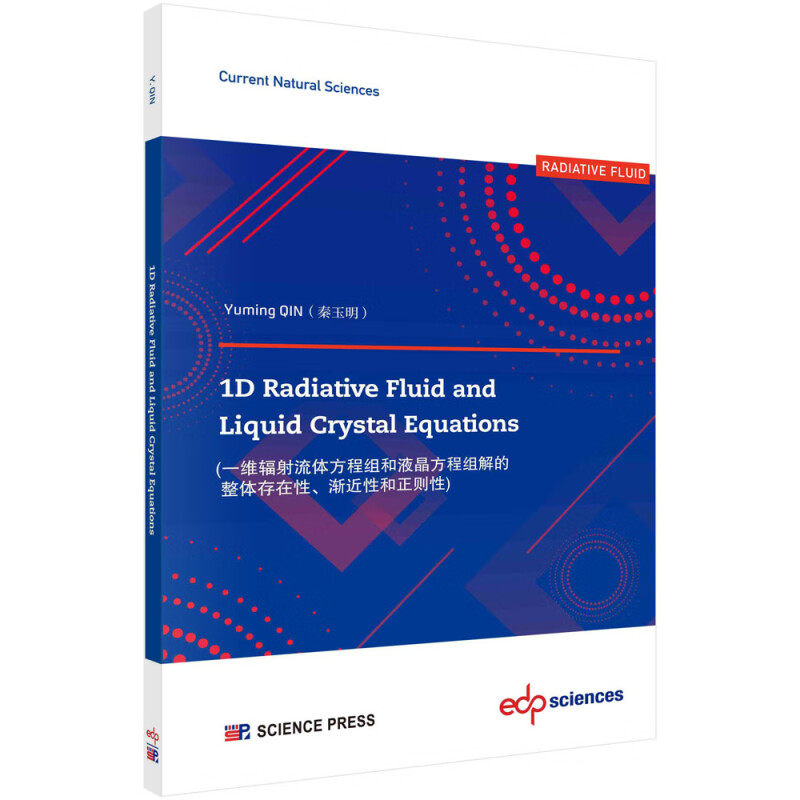
包邮一维辐射流体方程组和液晶方程组解的整体存在性、渐近性和正则性(英文)

- ISBN:9787030721372
- 装帧:一般胶版纸
- 册数:暂无
- 重量:暂无
- 开本:B5
- 页数:152
- 出版时间:2022-10-01
- 条形码:9787030721372 ; 978-7-03-072137-2
内容简介
Thisbookisaimedatpresentingsomerecentresultsonsomenonlinearevolutionaryfluidequations,includingtheglobalwell-posednessandexistenceofattractorsofsolutionstoradiativefluidsequations,liquidcrystalequations.Mostofmaterialsofthisbookarebasedontheresearchcarriedoutbytheauthorsandtheircollaboratorsinrecentyears.Someofithasbeenpreviouslypublishedonlyinoriginalpapers,andsomeofthematerialhasneverbeenpublisheduntilnow.
目录
Foreword i
CHAPTER 1 Preliminary 1
1.1 Some Basic Inequalities 1
1.1.1 The Sobolev Inequalities 1
1.1.2 The Interpolation Inequalities 5
1.1.3 The Poincare Inequality 6
1.1.4 The Classical Bellman-Gronwall Inequality 7
1.1.5 The Generalized Bellman-Gronwall Inequalities 8
1.1.6 The Uniform Bellman-Gronwall Inequality 9
1.1.7 The Young Inequalities
1.1.8 The Holder Inequalities 13
1.1.9 The Minkowski Inequalities 14
CHAPTER 2 Asymptotic Behavior of Solutions for the One-Dimensional Infrarelativistic Model of a Compressible Viscous Gas with Radiation 17
2.1 Main Results 17
2.2 Global Existence and Uniform-in-Time Estimates in H1 22
2.3 Asymptotic Behavior of Solutions in Hi 48
2.4 Global Existence and Uniform-in-Time Estimates in H2 53
2.5 Asymptotic Behavior of Solutions in H2 60
2.6 Global Existence and Uniform-in-Time Estimates in H4 62
2.7 Asymptotic Behavior of Solutions in H4 81
2.8 Bibliographic Comments 85
CHAPTER 3 Global Existence and Regularity of a One-Dimensional Liquid Crystal System 89
3.1 Main Results 89
3.2 Global Existence in 91
3.3 Proof of Theorem 3.1.2 100
3.4 Proof of Hheorem 3.1.3 103
3.5 Bibliographic Comments 109
CHAPTER 4 Large-time Behavior of Solutions do p One-Dimensional Liquid Crystal System 111
4.1 Introduction 111
4.2 Uniform Estimates in 113
4.3 Laxge-time Behavior in 122
4.4 Bibliographic Comments 134
Bibliography 135
Index 143
节选
Chapter 1 Preliminary This chapter will introduce some basic results, most of which will be used in the following chapters. First we shall recall some basic inequalities whose detailed proofs can be found in the related literature, see, e.g., Adams [1,2], Friedman [37, 38], Gagliardo [40,41], Nirenberg [95, 96], Yosida [148], etc. 1.1 Some Basic Inequalities 1.1.1 The Sobolev Inequalities We shall first introduce some basic concepts of Sobolev spaces. Definition 1.1.1. Assume is a bounded or an unbounded domain with a smooth boundary r. For 1 n and Q is bounded, and u G then u G C(Q) and (1.1.5) While, then (1.1.6) where measure the n-dimensional unit ball, T is the Euler gamma function and. Remark 1.1.1. The Sobolev inequality (1.1.4) does not hold for p = n, p* = +oo. (1.1.4) was first proved by Sobolev [138] in 1938. Sobolev [138] stated that the Lp* norm of u can be estimated by, the Sobolev norm of u. However, we can bound a higher Lp norm of u by exploiting higher order derivatives of u as shown in the next theorem which generalizes theorem 1.1.1 from m = 1, p > n to an integer. Theorem 1.1.2. Assume QCMn is an open domain. There exists a constant C = C(n,p) > 0 such that (1) if, and u G then and (1.1.7) (2) if mp > n, and u S VF0m,p(n), then and (1.1.8) where and diamK is the diameter of K. (1.1.8) Remark 1.1.2. An important case considered in theorems 1.1.1 and 1.1.2 is Q = Mw. In this situation, and therefore the results of theorems 1.1.1 and 1.1.2 apply to. For p > n, the results of theorems 1.1.1 and 1.1.2 imply the fact that u is bounded. Indeed, u is Hoder continuous, which we shall state as follows. Theorem 1.1.3. If ue, then where. Generally, the embedding theorems are closely related to the smoothness of the domain considered, which means that when we study the embedding theorems, we need some smoothness conditions for the domain. These conditions include that the domain Q possesses the cone property, and it is a uniformly regular open set in Mra, etc. For example, when or Lip, Q has the cone property. Mathematically, we need to define the special meaning of the word “embedding” or “compact embedding”. Definition 1.1.2. Assume A and B are two subsets of some function space. Set A is said to be embedded into B if and only if (1)A C B; (2) the identity mapping I: A B is continuous,i.e., there exists a constant C > 0 such that for any x ^ A, there holds that. If A is embedded into B, then we simply denote by. A is said to be compactly embedded into B if and only if (1) A is embedded into B; (2) the identity mapping I: is a compact operator. If A is compactly embedded into B,then we simply denote by A B. Now we draw some consequences from theorem 1.1.1. In fact, exploiting theorem 1.1.1, we have the following result which is an embedding theorem. Corollary 1.1.1. If then u G Lq(Q) with, and. Moreover,if p > n,u coincides. in Q with a (uniquely determined) function of C(Q). Finally,there holds that, (1.1.9) (1.1.10) (1.1.11) where C = C(n,p,q) > 0 is a constant. We can generalize corollary 1.1.1 to functions from VF0m,p(O) which can be stated as the following embedding theorem. Theorem 1.1.4. Let. Then (1) (1.1.12) and there is a constant C± > 0 depending only on m,p,q and n such that for all P, (1.1.13) (2) if mp = n, then we have,for all, (1.1.14) and there is a constant C2 > 0 depending only on m, p, q and n such that for all, (1.1.15) (3) if,each is equal a.e. in D. to a unique function in Ck(Q), for all and there is a constant C3 > 0 depending only on m, p, q and n such that (1.1.16) Remark 1.1.3. In case (2) of theorem 1.1.4, the following exception case holds for (1.1.17) Now we give the following compact embedding theorem. Theorem 1.1.5 (Embedding and Compact Embedding Theorem). Assume that Q is a bounded domain
-

13次时空穿梭之旅
¥18.7¥59.0 -

递归求解
¥9.4¥28.0 -

勒维特之星-大发现系列丛书
¥5.0¥16.0 -

核科学基本原理
¥14.5¥39.8 -

技术史入门
¥15.4¥48.0 -

天文学卷-异想天开-古今中外天文简史-《中国大百科全书》普及版
¥6.1¥19.0 -

科学哲学——科学家的视角
¥43.9¥78.0 -

发现之旅数的王国——世界共通的语言
¥41.1¥68.0 -

声音简史
¥23.9¥52.0 -

青少年及成.人普林斯顿数学分析读本
¥43.1¥69.0 -

130种美鸟彩图馆
¥15.3¥39.8 -

疯狂实验史-II
¥23.7¥36.0 -

控制论的发生与传播研究
¥6.0¥15.0 -

北宋科技思想研究纲要
¥9.8¥26.0 -

概率统计
¥5.7¥11.0 -

新科学时代的思考
¥46.2¥78.0 -

智慧宫029梦游者:西方宇宙观念的变迁
¥75.5¥128.0 -

现代生物特征识别技术
¥34.8¥49.0 -

羌塘盆地构造演化与油气生成和保存
¥229.0¥318.0 -

中国母乳营养成分地理分布图集(2024年)
¥58.2¥88.0











